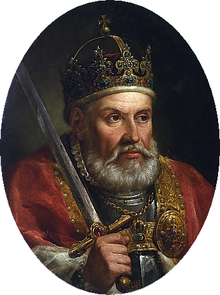Zygmunt Stary
| Sigismund I the Old | |
|---|---|

A modern depiction of Sigismund I from the 18th century by Marcello Bacciarelli
|
|
|
King of Poland Grand Duke of Lithuania |
|
| Reign | 8 December 1506 – 1 April 1548 |
| Coronation | 24 January 1507 in Wawel Cathedral, Kraków |
| Predecessor | Alexander I |
| Successor | Sigismund II Augustus |
| Born |
1 January 1467 Kozienice, Poland |
| Died | 1 April 1548 (aged 81) Kraków, Poland |
| Burial | 7 July 1548 Wawel Cathedral, Kraków |
| Spouses |
Barbara Zápolya Bona Sforza |
| Issue more... |
Hedwig, Electress of Bradenburg Isabella, Queen of Hungary Sigismund II Augustus Sophia, Duchess of Brunswick-Lüneburg Anna I of Poland Catherine, Queen of Sweden |
| Dynasty | Jagiellon |
| Father | Casimir IV of Poland |
| Mother | Elisabeth of Austria |
| Signature | |
Sigismund I of Poland (Polish: Zygmunt I Stary, Lithuanian: Žygimantas I Senasis; 1 January 1467 – 1 April 1548), of the Jagiellon dynasty, reigned as King of Poland and also as the Grand Duke of Lithuania from 1506 until 1548. Earlier, Sigismund had been invested as Duke of Silesia. A successful monarch and a great patron of arts, he established Polish suzerainty over Ducal Prussia (East Prussia) and incorporated the duchy of Mazovia into the Polish state, securing the nation's wealth, culture and power.
Sigismund I, the fifth son of Casimir IV and Elisabeth of Habsburg, had ruled Głogów, Silesia, since 1499 and became margrave of Lusatia and governor of all Silesia in 1504. In a short time his judicial and administrative reforms transformed those territories into model states. He succeeded his brother Alexander I as grand prince of Lithuania and king of Poland in 1506. Although he established fiscal and monetary reforms, he often clashed with the Polish Diet over extensions of royal power. At the Diet’s demand he married Barbara, daughter of Prince Stephen Zápolya of Hungary, in 1512, to secure a defense treaty and produce an heir. She died three years later, however, leaving only daughters. In 1518 Sigismund married the niece of the Holy Roman emperor Maximilian, Bona Sforza of Milan, by whom he had one son, Sigismund II Augustus, and four daughters. His daughter Catherine later married John III of Sweden, from whom the Vasa kings of Poland were descended.
In 1521 Sigismund made peace with his nephew Albert, Grand Master of the Teutonic Knights, a paramilitary religious order that ruled East Prussia. Albert became a Lutheran and converted the Teutonic state to Protestantism in 1525, defecting from both the Papacy and Holy Roman Emperor and agreeing to do public homage to Sigismund in return for being granted the title of secular duke of Prussia and Ducal Prussia coming under Polish suzerainty. Sigismund added the duchy of Mazovia (now the province of Warsaw) to the Polish state after the death, in 1529, of the last of its Piast dynasty rulers. Again under the command of Tarnowski, Sigismund’s army defeated the invading forces of Moldavia at Obertyn in 1531 and Muscovy in 1535, thereby safeguarding Poland’s eastern borders.
...
Wikipedia
